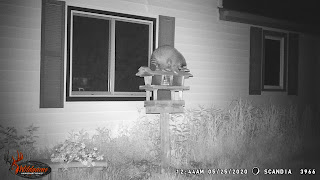Watch videos about raccoons.
We watched this one - Raccoons: Amazing Animals. Raccoons are opportunistic omnivores. They have very sensitive paws. There are seven species of raccoons, and most live between 2-5 years. That's such a short life!
We also watched this one - Raccoon demonstrates problem-solving skills. Rascal, the raccoon, shows how it can remember how to open a variety of locks to get through three compartments to receive treats and eventually leave the plexiglass tunnel.
We also watched Raccoon Nation and some of the short clips from the episode. The "First Night Out" one was interesting as a mother and her young raccoons went out and about. As dawn approaches, they need to find a hiding spot for the day. We learned that raccoons can collapse their backs to fit into smaller quarters.
Also on Raccoon Nation was "Filming Raccoons is Hard" which shows the difficulties of getting videos and pictures of raccoons at night.
Read pages 247-250 in the Handbook of Nature Study about the raccoon.
“The raccoon lives in hollow trees or caves along the banks of streams. It sleeps during the day and seeks its food at night. It sleeps during the winter.”
Do supplemental reading in The Burgess Animal Book for Children by reading Story 31.
We didn't do the nature walk because we knew that there would be no raccoons. It's easier for us to see them on the trail cam.
Read from the Handbook of Nature Study.
“None other of our little brothers of the forest has such a mischievous countenance as the coon. The black patch across the face and surrounding the eyes like large goggles, and the black line extending from the long, inquisitive nose directly up the forehead give the coon’s face an anxious expression; and the keenness of the big, beady, black eyes and the alert, “sassy” looking, broadly triangular ears, convince one that the anxiety depicted in the face is anxiety lest something that should not be done be left undone; and I am sure that anyone who has had experience with pet coons will aver that their acts do not belie their looks.”
-Handbook of Nature Study, pages 247-248
Read pages 247-250 in the Handbook of Nature Study about the raccoon.
“The raccoon lives in hollow trees or caves along the banks of streams. It sleeps during the day and seeks its food at night. It sleeps during the winter.”
Do supplemental reading in The Burgess Animal Book for Children by reading Story 31.
This story is called Bobby Coon and integrates facts about raccoons into the story. We learned some facts about raccoons including:
- they are nocturnal animals.
- they are wasteful eaters, especially when it comes to corn in cornfields.
- they are related to the bear family.
- the hindfoot shows the whole foot - including the heel and toes. It resembles a bear's footprint, but on a smaller scale.
- they eat eggs, young chickens, anything with flesh, fish, frogs, fruit, nuts, and insects.
- they like to wash their food before eating it.
- they give birth to more than one baby at a time.
- after the first snowfall, they typically hibernate in hollow trees.
- they can climb trees and move from treetop to treetop, if they are close together.
- they are most closely related to animal that is known by many different names: the Bassaris, the Civet Cat, the Coon Cat, or Cacomixtile. This animal lives in the far Southwest or the mountains of the West. This is what they look like:
Neither Olivia nor I had ever heard of the Bassaris, so reading this children's story was worthwhile. We learned something new.
Learn some facts about raccoons on the Adirondack Ecological Center's website.
The AEC has interesting facts about raccoons that we enjoyed reading.
Raccoons hibernate in the winter so there will be little chance of actually observing one this week. Instead, look for any animal tracks in the snow or mud. Keep your eyes out for any mammal that comes your way this week.
Additional resources for this challenge:
Raccoon coloring page
Raccoon information from Nature Works
Raccoon tracks
Raccoon coloring page
Raccoon information from Nature Works
Raccoon tracks
This is Olivia's nature journal page:








I love raccoons! Back in the 60s we could sell raccoons, monkeys, and skunks at the pet shops in Minneapolis. (Glad they don't allow that anymore!) The raccoons were like little Houdinis! I loved watching them use their tiny hands. Yes, they did like to wash their food before they ate it. Excellent climbers! Almost as much trouble as the monkey--LOL!
ReplyDelete